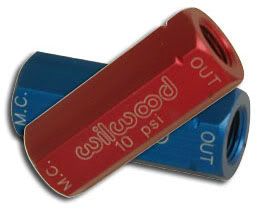We got these with the permission of publishers long reads but well worth it. MC may look different but the purpose and inner workings are the same.
Master Cylinders: The basic design of master cylinders are single reservoirs or dual reservoirs. Before disc brakes all master cylinders had single reservoir. This was because you wanted to apply equal pressure to all 4 drum brakes. The proportioning between the front and rear brakes was regulated by the size of the wheel cylinders. Generally you ran bigger wheel cylinders in front, because it applied more pressure and if you need fine tuning you added a manual proportioning valve to the system. In the late 60's and 70's when disc brakes were being used more and more, there was a need to have a dual master cylinder, because the requirements were different when you ran disc brakes in front and drums in the rear. Remember the volume requirements of the OEM caliper? Well this high volume and more pressure required the factories to build the master cylinders so it was cheap to produce, have a large volume and met the requirements of both the disc and drum brakes. Notice the larger reservoir in the front portion of the disc/drum master cylinder and the small reservoir for the drum brakes.
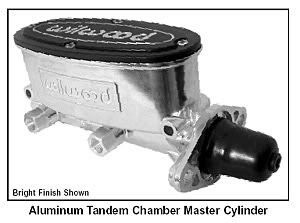 OEM single master cylinders are generally for drum brake applications. The earlier master cylinder had built in residual valves for the drum brake systems. This valve is needed so that the cup seals in the wheel cylinder has pressure against it preventing them from leaking. It also allows for a certain amount of pre-load on the mechanical parts. You can not use this master cylinder with built in residual valve(s) if you have disc brakes in front because of the residual valve. I have answered many questions regarding people that have installed brakes incorrectly by using a drum brake master cylinder.
OEM single master cylinders are generally for drum brake applications. The earlier master cylinder had built in residual valves for the drum brake systems. This valve is needed so that the cup seals in the wheel cylinder has pressure against it preventing them from leaking. It also allows for a certain amount of pre-load on the mechanical parts. You can not use this master cylinder with built in residual valve(s) if you have disc brakes in front because of the residual valve. I have answered many questions regarding people that have installed brakes incorrectly by using a drum brake master cylinder.If you experience a brake lock up after a few applications of the brake pedal, it is directly related to a residual valve retaining the brake fluid within the lines and not allowing the fluid to flow back to the master cylinder. The problem is either the wrong residual valve being used, a drum brake master cylinder being used on disc brake calipers, a inline residual valve plumbed in to the brake system with a built in residual valve in the master cylinder or a defective residual valve.
Most OEM tandem master cylinders will have a residual valve built in when there is a drum brake application. That is why it is important to buy the correct master cylinder based to application. Yes, you can remove the residual valve from the master cylinder, but often the reservoir is to small and it does not hold enough brake fluid for the disc brake application. So great care must be taking when using a modified master cylinder. OEM tandem master cylinders were designed to be cheap. Careful consideration should be made when selecting the master cylinder, because of the high volume of brake fluid required and pressure for the disc brake application. OEM tandem master cylinders do not produce the same volume as two side by side master cylinders. Remember the application is stacked one in front of each other so you have a limited travel and volume to work with.
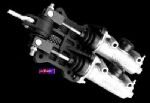 For over 30 years race cars have used dual master cylinders, this is the use of two master cylinders that are side by side being applied at the same time. The mounting is generally done on the fire wall, but special applications have made it possible to mount these on the floor, under the dash or in a remote location. A balance bar is used to balance the force to each master cylinder. Think of a bar with a pivot point in the middle, when pressure is applied to the pivot point both ends move the same distance. Now think of the same bar with the pivot point move more to one side, when pressure is applied the shorter end will move before the long end. That is basically how the balance bar works. In a race car there is a cable connected to one end of the balance bar, this cable would go to a knob in the drivers compartment, so he can make adjustments as the condition of his brakes and road condition changes. The balance bar also eliminatesthe need for a proportional valve. On certain applications a remote reservoir(s) are used, in these applications it deletes the use of residual valves on disc brake applications. Master cylinders of this type do not have built in residual valves in them so if you have a drum brake application you will still need an inline ten pound residual valve, this is needed to retain pressure against the cups of the wheel cylinders.
For over 30 years race cars have used dual master cylinders, this is the use of two master cylinders that are side by side being applied at the same time. The mounting is generally done on the fire wall, but special applications have made it possible to mount these on the floor, under the dash or in a remote location. A balance bar is used to balance the force to each master cylinder. Think of a bar with a pivot point in the middle, when pressure is applied to the pivot point both ends move the same distance. Now think of the same bar with the pivot point move more to one side, when pressure is applied the shorter end will move before the long end. That is basically how the balance bar works. In a race car there is a cable connected to one end of the balance bar, this cable would go to a knob in the drivers compartment, so he can make adjustments as the condition of his brakes and road condition changes. The balance bar also eliminatesthe need for a proportional valve. On certain applications a remote reservoir(s) are used, in these applications it deletes the use of residual valves on disc brake applications. Master cylinders of this type do not have built in residual valves in them so if you have a drum brake application you will still need an inline ten pound residual valve, this is needed to retain pressure against the cups of the wheel cylinders.There are major advantages to using dual master cylinders:
(1) Smaller diameter master cylinders can be used to increase output pressure. The design allows the application of two master cylinders being applied at the same, thereby doubling the volume output. Because of this high pressure output you will not need a vacuum booster. If you are running any type of camshaft, chances are you do not have enough vacuum to run the booster anyway. (2) The balance bar eliminates the use of a proportional valve and gives you the optional remote adjustment. (3) The remote fill applications deletes the need for residual valve normally used when the reservoirs are lower than the calipers.
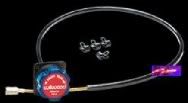
When calculating the output pressure of each master cylinder you can not say that applied pressure is “shared” equally between the two (2) master cylinders. If the two master cylinders did not have a balance bar between them and the application of force was always equally distributed this statement would be true. The balance bar allows the applied pressure to be distributed unequally.
Example:
6:1 ratio pedal assembly
¾" master cylinders
Applied force of 100 pounds with your foot
The formula shows that this combination produces 1359 psi, however if you apply the 100 pounds of force to both of them equally it will only produce 50 percent or 679.5 psi.
What the balance bar allows you to do is apply 65% of the force to the front and 35% to the rear so the actual output pressures would be 883 & 475 psi.
This is how you are able to obtain maximum braking with the same amount of applied force. When you are using a tandem master cylinder (OEM type inline bore) the output pressure is equal in both ports and the only way to reduce the pressure to the rear braking system is through metering (distribution block, combination valve or engineering in the master cylinder) or proportional valve. This works fine when you have more than enough pressure with a power booster but when you are using a manual master cylinder this energy is “wasted”.
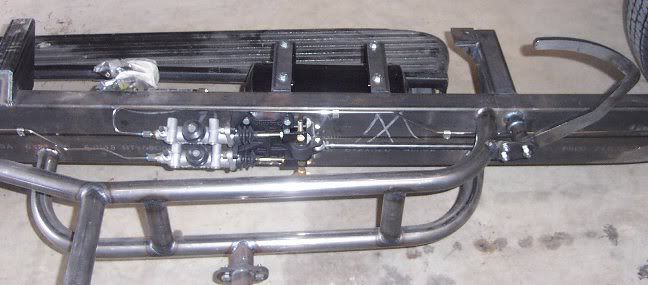
Here is a picture of the master cylinder mounting in one of my chassis I built. We have taken the 30 year old technology of dual master cylinders and applied it to this chassis. We used two 3/4 master cylinders with an out put pressure of 1359 psi each. This special mounting bracket mounts the master cylinders one on top of the other taking only 2.5 inches of width along the frame. The balance bar system allows full adjustment of the pressure balance and the remote fill eliminates the residual valves. This space saving feature provides additional room for your exhaust system. The deletion of the power booster also eliminates the need for vacuum.
